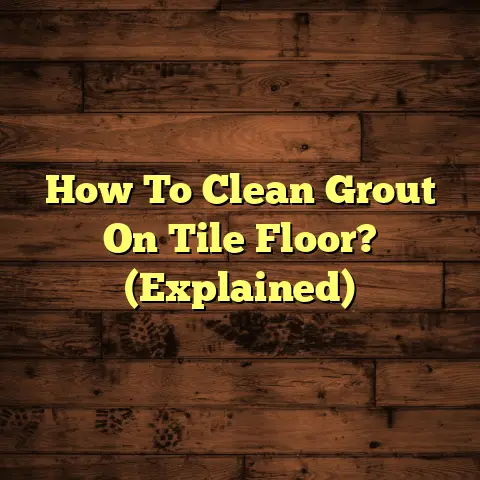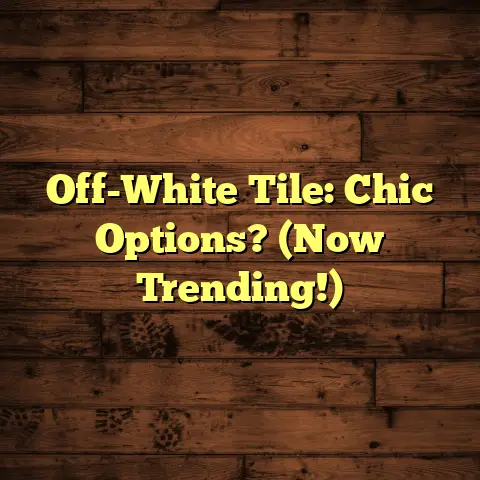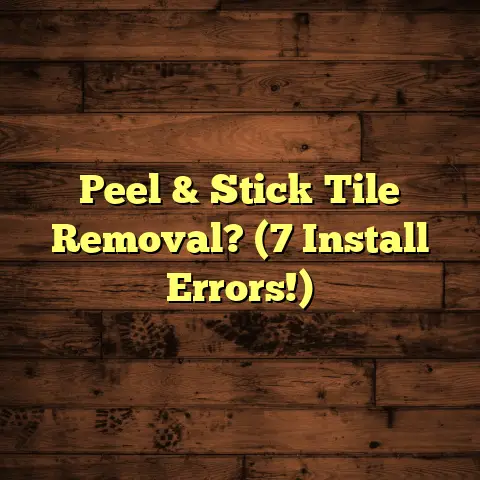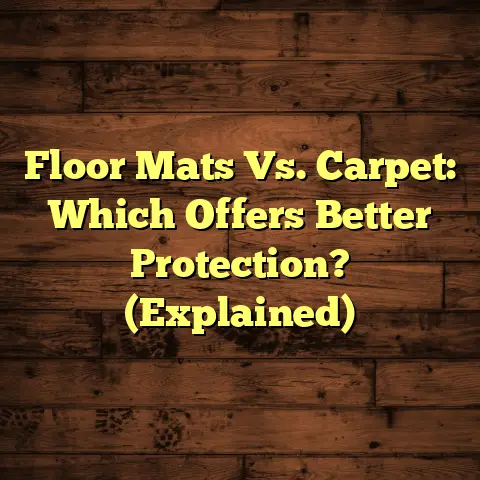Vinyl vs Laminate For Pets? (3 Must-Knows!)
It’s not just about aesthetics; it’s about creating a home that’s both beautiful and functional for everyone living there.
With pet ownership on the rise – I mean, who doesn’t love a furry companion?
– the demand for durable, pet-friendly flooring is skyrocketing.
But with so many options out there, how do you choose?
Today, we’re diving deep into the world of vinyl and laminate flooring to see which reigns supreme for pet owners.
Think of this as your fast track to solving those nagging flooring issues that come with having pets.
I’m going to break down the three must-knows: durability, water resistance, and comfort.
By the end of this, you’ll be armed with the knowledge to make the best decision for your home and your beloved pets.
Ready to get started? Let’s jump in!
Section 1: Durability and Scratch Resistance
Overview of Durability
Okay, let’s talk durability.
In the flooring world, durability basically means how well a material holds up against everyday wear and tear.
Think foot traffic, furniture moving, and, of course, those adorable but destructive pet claws.
The key here is understanding wear layers.
Both vinyl and laminate have them, but they’re not created equal.
The wear layer is the top surface that protects the flooring from scratches, stains, and fading.
The thicker the wear layer, the more durable the flooring.
For vinyl, wear layers are measured in mils (thousandths of an inch).
I generally recommend a wear layer of at least 20 mils for homes with pets.
Laminate wear layers are rated using an AC (Abrasion Class) rating, from AC1 to AC5.
For pets, you’ll want AC3 or higher.
Scratch Resistance
Now, let’s get to the nitty-gritty: scratch resistance.
This is where the battle between vinyl and laminate really heats up.
Generally speaking, vinyl tends to be more scratch-resistant than laminate.
Why?
Because it’s more flexible and has a cushioned surface.
When a pet’s claw makes contact, vinyl is more likely to give, rather than scratch.
Laminate, on the other hand, has a rigid surface.
While it’s tough, it’s more prone to scratching, especially from larger dogs or pets with untrimmed claws.
According to a study by the American Pet Products Association, over 60% of US households own a pet.
That’s a lot of potential claw action!
And those claws can do some serious damage.
I’ve seen countless homes where laminate flooring is riddled with scratches from pets.
It not only looks bad but also creates tiny grooves where dirt and bacteria can accumulate, leading to maintenance headaches down the road.
Think about it: those scratches aren’t just cosmetic.
They can affect the resale value of your home and make it harder to keep clean.
Fast Solutions for Durability Issues
So, what can you do if your flooring is already scratched?
Don’t panic!
There are solutions.
For Scratched Vinyl: You can often buff out minor scratches with a soft cloth and a specialized vinyl floor cleaner.
For deeper scratches, consider using a vinyl repair kit.
These kits usually contain a color-matching filler that you can apply to the scratch and then smooth out.For Scratched Laminate: Unfortunately, fixing laminate scratches is a bit trickier.
Minor scratches can sometimes be concealed with a laminate repair marker that matches the color of your floor.
For deeper scratches, you might need to replace the damaged planks.
Preventive Measures are Key!
Mats and Rugs: Strategically placed mats and rugs can do wonders.
Put them in high-traffic areas, like doorways and hallways, to protect your flooring from scratches and dirt.Regular Nail Trimming: This is a no-brainer, but it’s worth repeating.
Keep your pet’s nails trimmed to minimize scratching.
I recommend doing it every 2-3 weeks.Choose Wisely: When selecting flooring, look for products specifically designed for pets.
These often have thicker wear layers and enhanced scratch resistance.For example, some vinyl flooring brands offer products with a “pet-proof” guarantee.
These are definitely worth considering if you have active pets.
Section 2: Water Resistance and Maintenance
Water Resistance Explained
Alright, let’s talk about water resistance.
This is huge when you have pets, because accidents happen.
Whether it’s a spilled water bowl, a muddy paw print, or, ahem, something else, your flooring needs to be able to handle moisture.
Here’s the deal: vinyl is inherently waterproof.
It’s made of plastic, so water just sits on the surface.
Laminate, on the other hand, is not waterproof.
It’s made of compressed wood fibers, which can swell and warp when exposed to moisture.
Now, some laminate flooring is labeled as “water-resistant,” but that doesn’t mean it’s completely impervious to water.
It just means it can withstand spills for a limited amount of time.
The key difference lies in the core of the flooring.
Vinyl has a solid, waterproof core, while laminate has a wood-based core that’s susceptible to water damage.
Think about this scenario: Your dog has an accident while you’re at work.
With vinyl, you can simply wipe it up when you get home, and no harm is done.
With laminate, the liquid can seep into the seams and cause the flooring to swell and buckle.
I’ve seen countless laminate floors ruined by pet accidents.
The repair costs can be significant, not to mention the hassle of replacing the flooring.
Maintenance Concerns
Okay, so vinyl wins on water resistance, but what about maintenance?
Both vinyl and laminate are relatively easy to clean, but there are some key differences.
Vinyl is super low-maintenance.
You can simply sweep or vacuum it regularly and mop it with a damp mop and a mild cleaner.
No special treatments are needed.
Laminate requires a bit more care.
You need to be careful not to use too much water when mopping, as this can seep into the seams and cause damage.
You should also avoid using harsh chemicals, as they can damage the surface.
When it comes to cleaning up pet messes, vinyl is the clear winner.
It’s non-porous, so it doesn’t absorb stains or odors.
Laminate, on the other hand, can absorb stains and odors if spills aren’t cleaned up quickly.
I’ve seen some pretty nasty stains on laminate flooring that were impossible to remove, even with professional cleaning.
Fast Solutions for Water Resistance and Maintenance
So, what can you do to protect your flooring from water damage and make maintenance easier?
Immediate Action: If your pet has an accident, clean it up immediately.
The longer it sits, the more likely it is to cause damage.Specific Cleaning Solutions: Use cleaning products specifically designed for vinyl or laminate flooring.
Avoid using harsh chemicals, bleach, or abrasive cleaners.Homemade Remedies: For vinyl, a mixture of vinegar and water can work wonders for cleaning up spills and removing odors.
For laminate, use a damp cloth with a mild dish soap.Routine Maintenance: Sweep or vacuum your floors regularly to remove dirt and debris.
Mop them weekly with a damp mop and a mild cleaner.Consider Waterproof Laminate: If you’re set on laminate, look for waterproof options.
These have a special coating that protects them from water damage.
However, keep in mind that even waterproof laminate isn’t completely impervious to water, so you still need to clean up spills quickly.Use Pet-Friendly Cleaners: Many cleaning products contain chemicals that can be harmful to pets.
Look for pet-friendly cleaners that are made with natural ingredients.I’ve found that enzymatic cleaners are particularly effective at removing pet odors.
Section 3: Comfort and Noise Reduction
Comfort for Pets
Let’s talk comfort.
It’s easy to overlook, but the type of flooring you choose can have a big impact on your pet’s well-being.
Think about it: your pets spend a lot of time lying on the floor.
If it’s too hard or cold, it can be uncomfortable for them, especially for older pets with joint problems.
Vinyl tends to be more comfortable than laminate.
It has a softer, more cushioned surface, which can be easier on your pet’s joints.
Laminate, on the other hand, is harder and colder.
It can also be slippery, which can be a problem for older pets or those with mobility issues.
The thermal properties of flooring also play a role.
Vinyl tends to be warmer than laminate, which can be a plus in colder climates.
I’ve seen many pet owners add area rugs to their laminate floors to provide their pets with a more comfortable place to lie down.
Noise Reduction
Noise reduction is another important consideration, especially if you live in an apartment or have neighbors close by.
Pets can be noisy, whether it’s the click-clack of their claws on the floor or the sound of them running and playing.
Vinyl tends to be quieter than laminate.
It has better sound absorption qualities, which means it can help to dampen noise.
Laminate, on the other hand, can be quite noisy, especially when pets are walking or running on it.
I’ve had clients complain about the noise their dogs make on laminate floors, especially at night when everyone else is trying to sleep.
Fast Solutions for Comfort and Noise Issues
So, what can you do to enhance comfort and reduce noise?
Add Underlayment: Underlayment is a layer of material that goes between the subfloor and the flooring.
It can provide extra cushioning and sound absorption.Area Rugs: Area rugs are a great way to add comfort and warmth to your floors.
They can also help to reduce noise.Pet Beds: Provide your pets with comfortable beds to lie down in.
This will give them a cozy place to rest and keep them off the hard floor.-
Noise-Dampening Techniques: Consider using noise-dampening curtains or wall hangings to absorb sound.
-
Choose Thicker Vinyl: If you’re concerned about comfort, choose a thicker vinyl flooring with a cushioned backing.
Consider Cork Underlayment: Cork is a natural material that provides excellent cushioning and sound absorption.
It’s a great option for underlayment.Specialized Pet Mats: Look for mats designed specifically for pets.
These often have a non-slip surface and are easy to clean.
Conclusion
Okay, we’ve covered a lot of ground!
Let’s recap the three must-knows when choosing between vinyl and laminate flooring for pets:
-
Durability and Scratch Resistance: Vinyl generally wins here, as it’s more scratch-resistant than laminate.
-
Water Resistance and Maintenance: Vinyl is the clear winner, as it’s waterproof and easy to clean.
-
Comfort and Noise Reduction: Vinyl tends to be more comfortable and quieter than laminate.
Ultimately, the best choice for you will depend on your specific needs and preferences.
Consider your budget, your lifestyle, and your pet’s personality.
If you have active pets who are prone to accidents, vinyl is probably the better choice.
If you’re on a tight budget and are willing to take extra care to protect your floors, laminate might be a viable option.
No matter what you choose, remember that your flooring is an investment.
By making an informed decision, you can create a home that’s both beautiful and functional for you and your furry friends.
And remember, a happy pet makes for a happy home!
So choose wisely and enjoy your time with your beloved companions.





